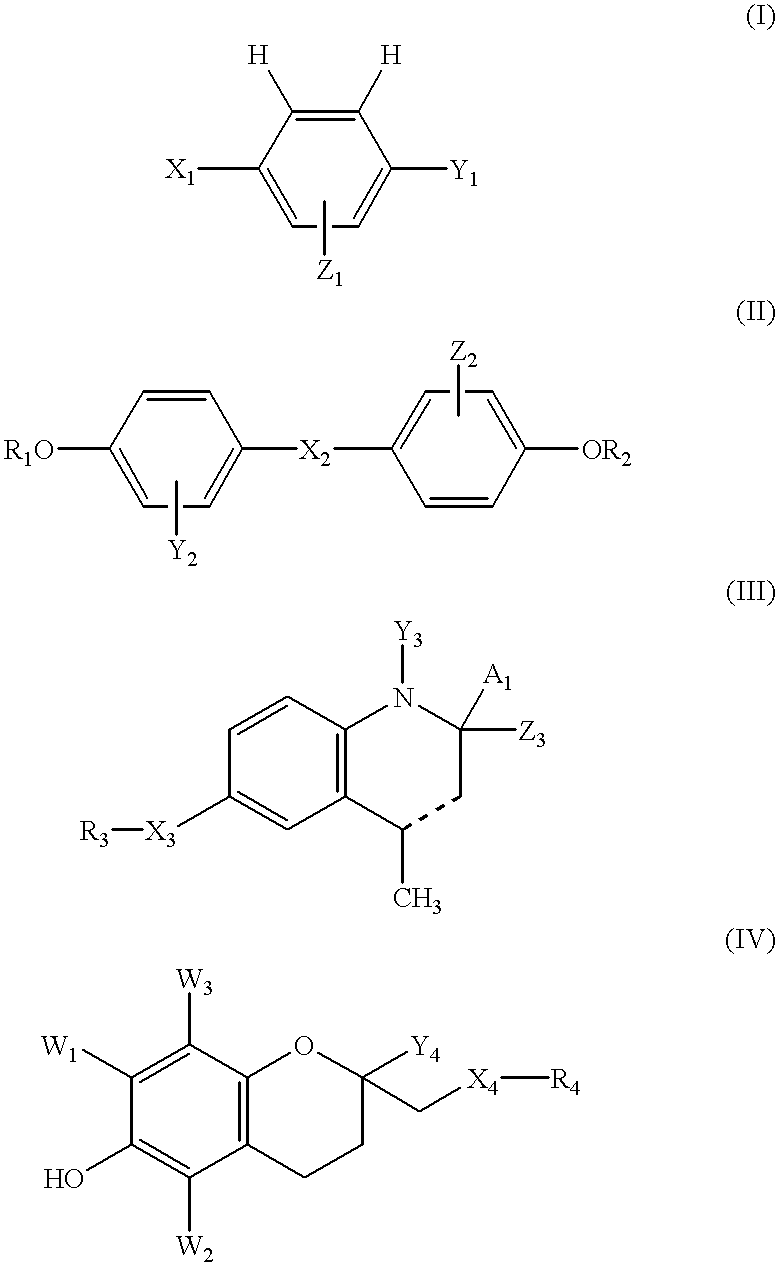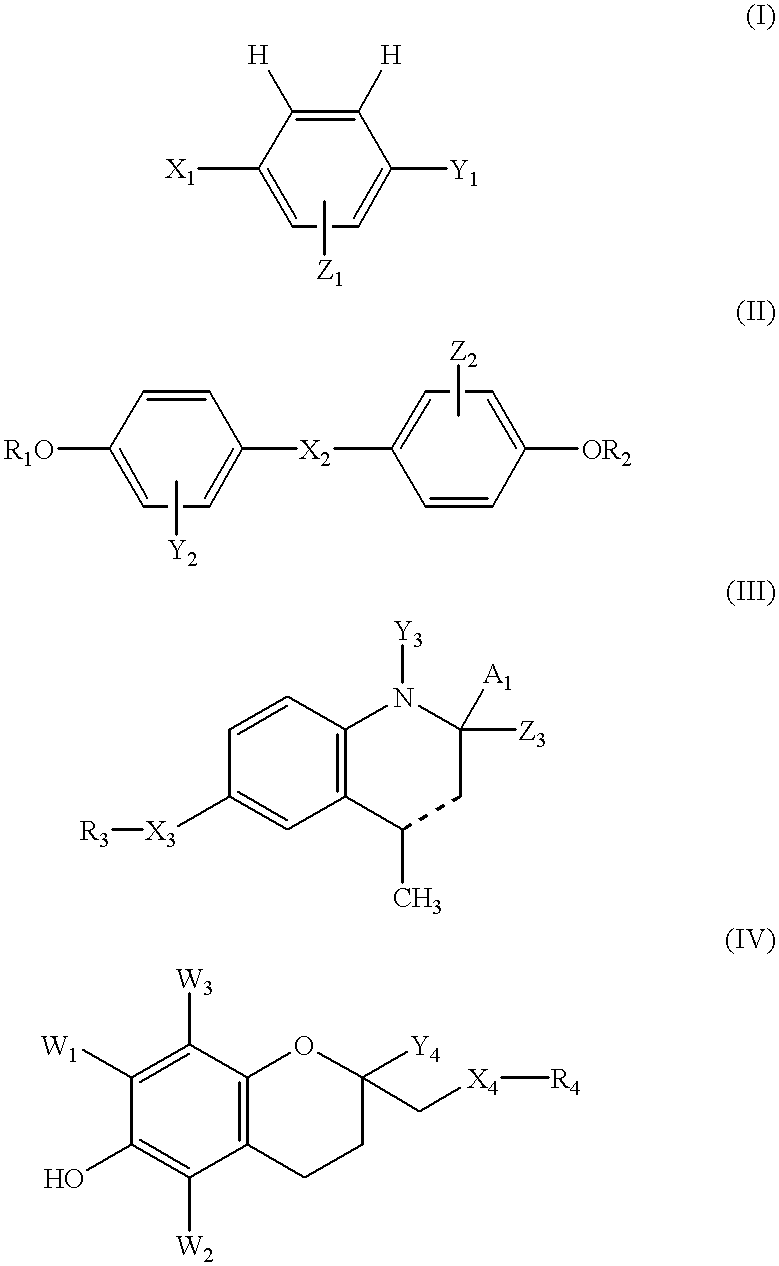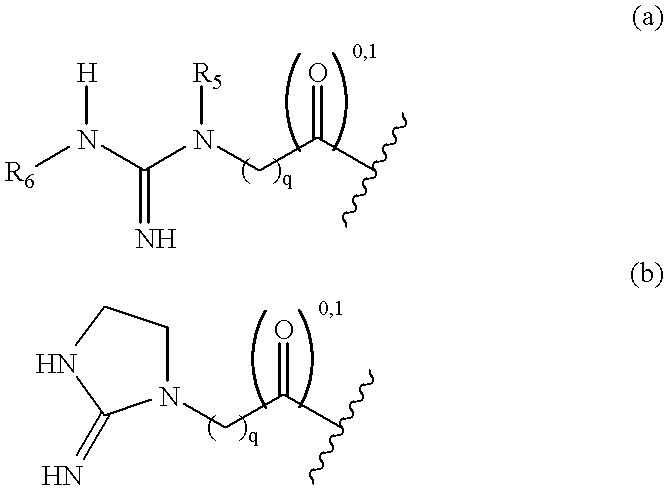Mitochondria protecting agents for treating mitochondria associated diseases
a technology protecting agent, which is applied in the field of mitochondrial membrane potential maintenance and inhibition of the loss of mitochondrial membrane potential
- Summary
- Abstract
- Description
- Claims
- Application Information
AI Technical Summary
Benefits of technology
Problems solved by technology
Method used
Image
Examples
example 1
DCFC Assay for Inhibition of ROS Production by Mitochondria Protecting Agents
[0146] In the cell-based aspect of the DCFC assay, monolayers of cultured adherent SH-SY5Y human neuroblastoma cells (Biedler et al., Cancer Res. 33:2643, 1973) at or near confluence were rinsed and harvested using trypsin according to standard methods. Single cell suspensions containing 7.5.times.10.sup.4 cells in 200 .mu.l of medium were seeded into 96-well plates for overnight incubation at 37.degree. C. and 5% CO.sub.2 in a humidified cell atmosphere. The following day the wells were gently rinsed once with warm Hanks balanced saline solution (HBSS, Gibco-BRL), 200 .mu.l of 30 .mu.M dichlorofluorescin-diacetate (DCFC-DA, Molecular Probes, Eugene, Oreg.) were added to each well and cultures were incubated for 2 hours at 37.degree. C. / 5% CO.sub.2. The excess DCFC-DA was removed by needle aspiration and each well was gently rinsed twice with HBSS. Each well then received 80 .mu.l of HBSS and 10 .mu.l of mi...
example 2
Assay for Mitochondrial Permeability Transition Using DASPMI
[0151] The fluorescent mitochondria-selective dye 2-,4-dimethylaminostyryl--N-methylpyridinium (DASPMI, Molecular Probes, Inc., Eugene, Oreg.) is dissolved in HBSS at 1 mM and diluted to 25 .mu.M in warm HBSS. In 96-well microculture plates, cultured human cells from an individual known or suspected of having a mitochondria associated disease, or normal (control) cells, are incubated for 0.5-1.5 hrs in 25 .mu.M DASPMI in a humidified 37 C. / 5% CO.sub.2 incubator to permit mitochondrial uptake of the fluorescent dye. Culture supernatants are then removed and candidate mitochondria protecting agents diluted into HBSS from DMF or DMSO stocks, or vehicle controls, are added at various concentrations.
[0152] Fluorescence of each microculture in the 96-well plate is quantified immediately using a Cytofluor fluorimetric plate reader (model #2350, Millipore Corp., Bedford, Mass.; excitation wavelength=485 nm; emission wavelength=530 ...
example 3
Effect of Mitochondria Protecting Agents on Apoptosis
[0153] In 96-well microculture plates, cultured human cells from an individual known or suspected of having a mitochondria associated disease, or normal (control) cells or cell lines, are cultured for a suitable period in the presence or absence of physiological inducers of apoptosis (e.g., Fas ligand, TNF-.alpha., or other inducers of apoptosis known in the art) and in the presence or absence of candidate mitochondria protecting agents.
[0154] Exteriorization of plasma membrane phosphatidyl serine (PS) is assessed by adding to the 96 well plate annexing-fluorescein isothiocyanate conjugate (annexin-FITC, Oncogene Research Products, Cambridge, Mass.) dissolved in a suitable buffer for binding to cell surfaces at a final concentration of 5 .mu.g / well. (Martin et al., J. Exp. Med. 182:1545, 1995) After 15-30 min in a humidified 37.degree. C. / 5% CO.sub.2 incubator, cells are fixed in situ using 2% formalin, washed to remove non-specif...
PUM
| Property | Measurement | Unit |
|---|---|---|
| body weight | aaaaa | aaaaa |
| body weight | aaaaa | aaaaa |
| body weight | aaaaa | aaaaa |
Abstract
Description
Claims
Application Information
 Login to View More
Login to View More - R&D
- Intellectual Property
- Life Sciences
- Materials
- Tech Scout
- Unparalleled Data Quality
- Higher Quality Content
- 60% Fewer Hallucinations
Browse by: Latest US Patents, China's latest patents, Technical Efficacy Thesaurus, Application Domain, Technology Topic, Popular Technical Reports.
© 2025 PatSnap. All rights reserved.Legal|Privacy policy|Modern Slavery Act Transparency Statement|Sitemap|About US| Contact US: help@patsnap.com



